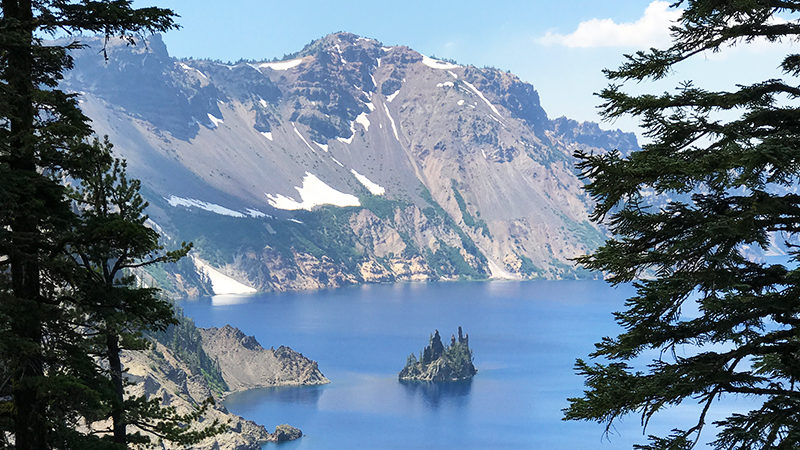
Kerr Notch and Sun Notch, are the lowest points on the south rim of Carter Lake’s caldera, and the last two scenic overlooks we visited on our visit to Crater Lake National Park.
Kerr Notch provides one of the two best views of Phantom Ship Island — a rocky island resembling a pirate ship that seems to appear and disappear as the light changes.
Named for United States Geological Survey topographer Mark Brickell Kerr, Kerr Notch is a u-shaped valley that was carved by glaciers moving down the side of Mount Mazama more than 10,000 years ago. During the great eruption and collapse of Mount Mazama, a portion of the valley fell into the crater and what’s left is considered a hanging valley.
View Of Phantom Ship
The best thing about our stop at Kerr Notch was the view of Phantom Ship, a 400,000 year-old eroded remnant of a volcanic dike that is 170 feet tall, 500 feet long, and 200 feet wide.
An Crater Lake interpretive sign at the Kerr Notch Phantom Ship Overlook reads:
At first glance, the dark, jagged island just offshore calls to mind the image of a ghostly ship with tall masts and dropping sails. Phantom Ship is actually a resistant remnant of an ancient volcanic cone that was engulfed in the glowing Mazama volcano. This vent shared the underground chamber that fed Mount Mazama and was part of Mazama’s early mountain building phase. These rocky spires remained after Mazama’s massive eruption and collapse, displaying the oldest rock in the Crater Lake basin.
As we peered through the trees at the island, we noticed that the trees were covered in yellow-green lichen but it doesn’t start until partway up the tree. Apparently, its because the lichen can’t survive below the snow line.
When we had finally had enough of the view, we hopped back in the car to take a detour away from the lake to visit the Pinnacles, an outcropping of rocky spires created from the fusion of volcanic gasses and pumice ash, and erosion over time.
Know Before You Go
- Crater Lake National Park, Oregon’s only national park, does not have a physical street address, so it can be hard to locate us using GPS. We made the historic Crater Lake Lodge our first stop, which is located at 565 Rim Drive, Klamath Falls, Oregon 97604.
- At 1,943 feet deep, Crater Lake is the deepest lake in the United States and the principal feature of Crater Lake National Park.
- The 33 mile Rim Drive that travels around Crater Lake’s caldera features spectacular views of the lake and interpretive signage at all of the main vista points.
- Good for seven days, admissions fees are $30.00/vehicle, $25.00/motorcycle in the summer and $15.00/motorcycle in the winter, and $15.00/pedestrian or bicycle.
- The national park is open year-round, 24 hours a day but many of the park’s roads, trails, and facilities are closed seasonally.
- During periods of rain and snow, Crater Lake is often hidden by clouds — it is completely invisible about 50% of the time in the winter!
- Summers at Crater Lake are short but typically sunny. July, August, and September are your best bets for warm, dry weather. However, it can snow any day of the year.
- The park’s North Entrance is closed for about seven months each year. It closes at the first snowfall or on November 1, whichever comes first and reopens in early to mid-summer. The park’s South Entrance and West Entrance are open year-round. We visited the park in late July and the roads had only been open for a week!
- Crater Lake National Park has two visitor centers. The Steel Visitor Center at Park Headquarters is open every day except December 25 — 9:00 am to 5:00 pm from mid-April to early November and 10:00 am to 4:00 pm the rest of the year. The Rim Visitor Center at Rim Village is open daily from late May to late September from 9:30 am to 5:00 pm.
- Dogs on-leash are permitted in developed areas of the park and in Mazama Village and Lost Creek Campground. Dogs are not permitted on any trails or in undeveloped areas.

